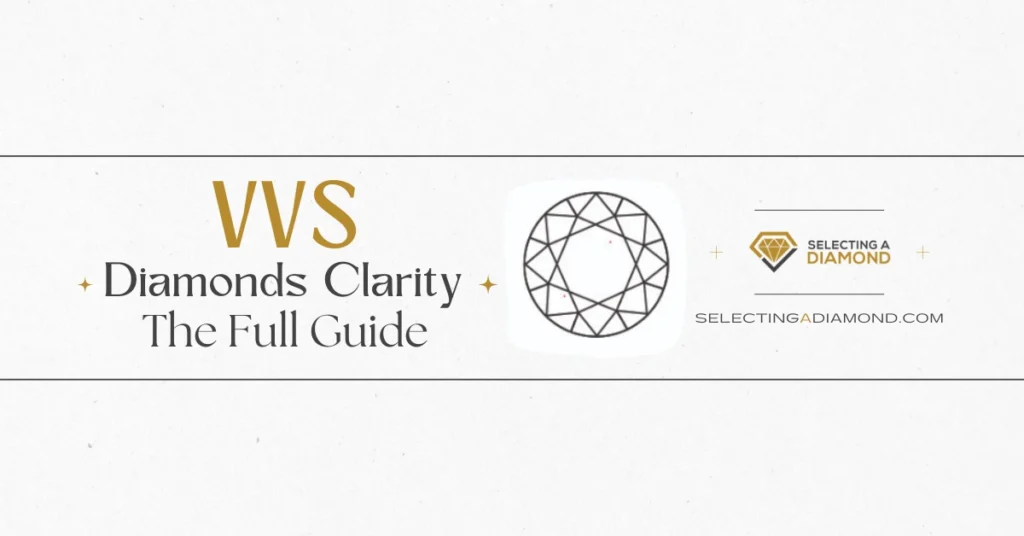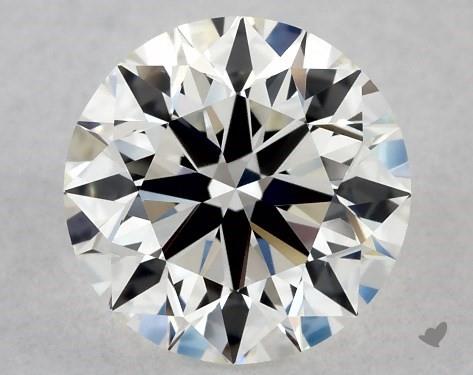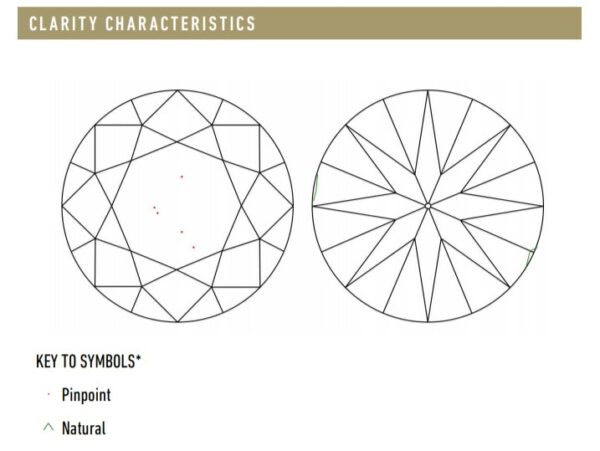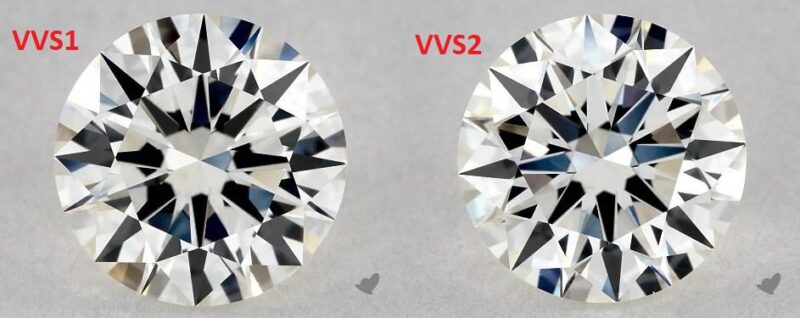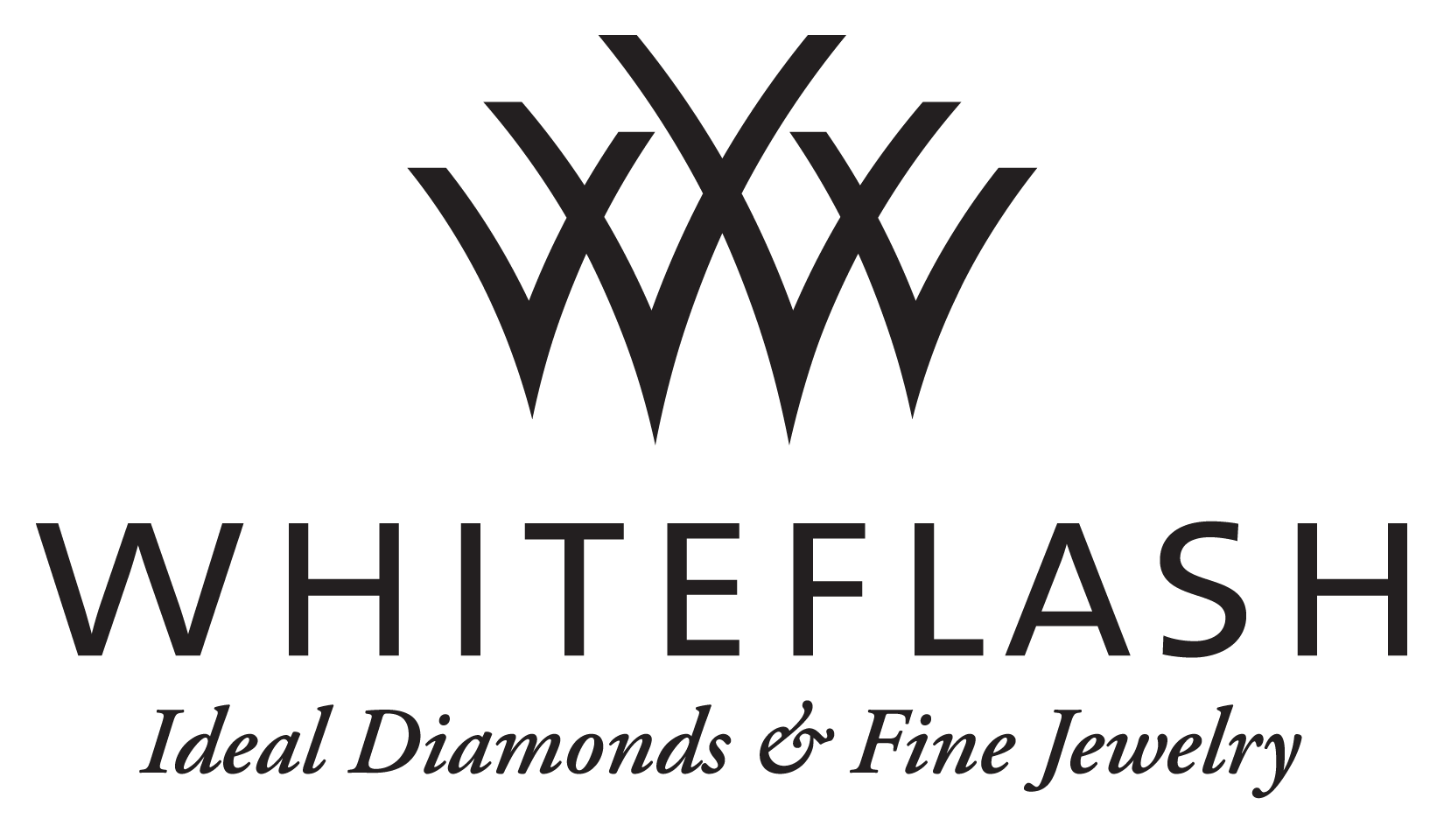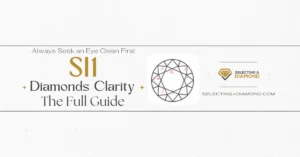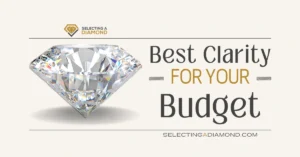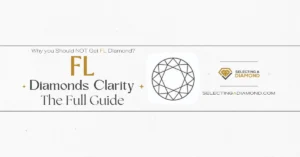We may earn a commission when you purchase through our affiliate links, at no extra cost to you. This helps support our work and allows us to continue providing unbiased, expert diamond advice.
When searching for a diamond, you will probably hear this acronym more than any other, the VVS clarity grade.
While it’s amazingly beautiful clarity group, it’s usually attached to a high price tag that you need to well-consider before getting it.
So what’s the deal with VVS clarity? How much diamonds with VVS cost? What’s the difference between VVS1 & VVS2? And last but not least, should you get one?
Let’s see.
What are VVS Diamonds?
VVS diamonds are essentially group of 2 diamonds grade, the VVS1 & VVS2 as defined by GIA in the official clarity scale.
Here is an image for this VVS diamond on James Allen, clearly beautiful, and ‘probably’ expensive compared to an average 1 carat diamond price.
What is diamond clarity?
Diamond clarity is a term used to describe the absence or presence of imperfections in a diamond, such as blemishes and inclusions. Blemishes are external flaws on the diamond’s surface, while inclusions are internal flaws that are trapped within the diamond as it forms.
Clarity grades & groups are created based on multiple factors, all related to imperfections found on the diamonds, like number, size, location and type of inclusions.
Then, what VVS means?
VVS stands for “Very Very Slightly Included”, the last word “included” here refers to the imperfections (inclusions & blemishes) that are “included” in the diamond itself.
Included here doesn’t necessarily mean you can see them, actually GIA themselves say that inclusions in VVS are difficult for a skilled grader to see under 10× magnification.
So the matter here is not whether the diamond has inclusions or not, since 99% of diamonds do have inclusions and/or blemishes, the point here is whether these inclusions are visibly to naked eye, and even if not visible, do they affect the durability & brilliance of the stone.
VVS is indeed eye clean, as said above, not only to your eye, but to an expert eye as well, since they will need 10x magnification and years of experience to detect these.
For example, this 1.5 VVS2 diamond on Blue Nile has some minimal inclusions as you can see in this GIA report for this diamond (and that’s one of the main reasons we always recommend getting a GIA-reported diamond):
Are you able to see these inclusions under the magnification? We doubt.
Clarity (along with color) might be the most characteristics that any diamond store will try to sell you highest grade they have for these! By convincing you that you must get the cleanest clarity so it doesn’t show any inclusions!
This is part of the true story, that any diamond should not be showing inclusions, BUT for naked-eye! And that’s a huge difference! Looking at diamond in naked-eye is not at all similar to inspecting it under 20x or even 40x magnification.
VVS Clarity Position on Clarity Scale
As mentioned above, GIA created the global standard for clarity grades, which consists on 11 grades, grouped into 6 different groups:
- FL (Flawless): No visible inclusions or blemishes under 10x magnification.
- IF (Internally Flawless): No visible inclusions, but minor blemishes may be present under 10x magnification.
- VVS1 and VVS2 (Very, Very Slightly Included): Inclusions are very difficult to see under 10x magnification.
- VS1 and VS2 (Very Slightly Included): Minor inclusions that are not visible to the naked eye.
- SI1 and SI2 (Slightly Included): Inclusions that are noticeable under 10x magnification, but the diamond is still considered to have good clarity.
- I1, I2, and I3 (Included): Inclusions that are visible to the naked eye and may affect the diamond’s durability, transparency, and brilliance.
So, as you see here, the VVS comes in the 3rd group, but visually it’s not like this, because there are 7 grades lower than VVS, and just 2 higher.
Here is a visual representation for diamond clarity chart:
Note that it’s very common to see flawless (FL) clarity grade grouped with internally flawless, since the difference between both is similar to nothing.
VVS Diamonds Prices
The short answer?
Very expensive!
We’re talking about the grade that comes right after FL-IF group, and we saw in internally flawless clarity review, these 2 grades make less than 3% of diamonds, do some estimations to have an idea how rare this grade is.
To get some idea about prices for VVS diamonds, it’s important to mention that besides the main 4Cs (which clarity is one of them), a lot of factors sum up the diamond price.
Shape, Polish, Symmetry, Depth & Table percentages, Fluorescence, Certification lab, and so on.
So if we want to give a price for VVS diamonds, we have to narrow down all other factors to make a reasonable price range, we will stick to:
Cut: Excellent
Color: G
Clarity: VVS1 & VVS2
Carat: 1
Shape: Round
Polish & Symmetry: Excellent
Fluorescence: None
Then run this search on James Allen.
As of writing, we got 144 round diamonds, ranging between $6400 and $9500.
We ran the same search on Blue Nile and got a little lower options (100 round diamond), that ranges from $6200 to $9000 for 1 carat diamonds as well.
From our diamond pricing guide, we know that 1 carat diamond price (with recommended 4Cs in general) ranges between $3800 to $6000, so we’re taking about an extra $2.5k above the price where you can get an astonishing diamond, like this one.
VVS1 vs VVS2: What’s the Difference?
5Vs & 3Ss in just 10 characters, a bit too much! Let’s see what’s the deal here, and what’s the difference between the 2 grades of VVS clarity group.
The similarities between VVS1 and VVS2 diamonds are well-known, because there isn’t a lot of difference between them (which is basically: Inclusions are difficult for a skilled grader to see under 10× magnification).
However, there must be a reason why they belong to different types right?
Well, the difference between the VVS1 and VVS2 is how fast their inclusions can be detected. Bear in mind that both diamond clarity grades are very close to internally flawless and most people (including jewelers) can’t tell the difference.
A little breakdown:
What is VVS1?
VVS1 is the higher grade in VVS group, adjacent and very close to internally flawless grade, which we know how rare it is, and how clean it is (actually IF grade doesn’t have any inclusions, just minor blemishes).
This reflects on the purity and cleanness of VVS1 grade, yes it does have inclusions, but for most skilled graders, they are not obvious immediately, it might take them minutes searching for them, or even they might need more than 10x magnification.
Minutes are too long here actually, since inclusions in lower grades (like VS1 or VS2) can be seen in less than 30 seconds, so for a skilled grader it’s a bit challenging to find inclusions in VVS1 in less than a minute.
For the record, some VVS1 diamonds have inclusions that are completely invisible under 10x, even for skilled graders.
What is VVS2?
Right after the VVS1 comes the next grade, Very Very Slightly Included – 2, which means that diamonds in this grade have inclusions that are very hard to be detected, even under 10x magnification.
The main difference compared to VVS1 is that in VVS2, inclusions are usually visible under 10x magnification by experts.
Timing here plays a role here, these inclusions need less time to be detected compared to the higher grade.
To the naked eye?
All are the same!
VVS2, VVS1, Internally Flawless, and Flawless (for most people, you can even count VS1 & VS2) are eye clean, they don’t show any inclusions when inspected by our naked eyes.
That’s why we always encourage seeking an eye clean diamond, rather than spending thousands on something that can be seen (and doesn’t make a huge difference to cover the price tag).
VVS1 vs VVS2 Visual Comparison
Here are two diamonds, magnified not at 10x but at 20x, the left one is VVS1, and the other is VVS2, if you look from a clarity perspective, you can never tell any difference:
If you want to compare in 360 view and 40x magnification, here is a link to a VVS1 diamond, and then take a look at this similar diamond but with a VVS2 clarity.
40x magnification is truly out of this world technology, they have a trademark for it named Diamond Display Technology™, we cover that in more details in our comprehensive James Allen review.
As a matter of fact, some trained eyes opt for binoculars set to 20X-30X magnification before they are able to spot the inclusions. So, you can imagine how flawless they are.
However, based on the position of the inclusions, you may tell which is VVS1 and VVS2. The VVS1 diamond’s inclusions are usually noticed from the bottom under when viewed under a magnification lens.
While diamonds under the VVS2 category has their inclusions noticed from the face view and usually in the top half of the diamond.
Where to Buy VVS Clarity Diamonds?
If you opt in to get a VVS diamond, here are some recommended stores that we recommend for their inventory, customer support, prices, and most importantly the imaging technology:
1. James Allen
If you’re looking for diamonds of VVS grade, James Allen is undoubtedly the leading player in the online diamond industry. With state-of-the-art imaging technology and a vast inventory of hundreds of thousands of diamonds, James Allen should be your first choice.
Currently they have 201k round diamonds, 43k of them are in VVS clarity range as you can see in this search.
2. Whiteflash
May not be as large as James Allen or Blue Nile since they specialize in premium & high quality diamonds, but they still have a good collection of VVS diamonds.
One of the impressive features of Whiteflash is their advanced imaging technology, which while not as exceptional as JA, is superior to most of the images available in the market.
3. Blue Nile
Summary: Is VVS Clarity Good Choice?
So, you’ve reached this point, and want to know our opinion whether to get a VVS diamond or it’s overrated?
We’ve mentioned that all what you want from a diamond clarity is a clean diamond, eye-clean, and no bad inclusions that might affect sparkle & brilliance.
All this can be accomplished without getting to VVS grade, and don’t be surprised if we tell you that you don’t even need to get a VS grade in most cases! Why?
Because you can get an eye-clean diamond, and without bad inclusions in most SI1 grade diamonds! That’s not what your local jeweler wants you to know by the way.
We encourage you to go and get the least eye-clean grade, you may not believe it, but SI (Slightly Included) is considered in most cases an eye-clean grade (for diamonds less than 1 carat).
What about brilliance that’s affected by clarity? The answer is simple, if you have more money to go above SI or VS2, spend it on what matters more, the CUT, why?
This article will give you the answer.
Still not sure where to buy your diamond?
We always recommend shopping diamonds online and created a Full guide to shop diamonds like a Pro.
Among online retailers, here are our favorite stores click their logo to visit store
-
James Allen:
Our favorite online store, best diamond imaging technology available today, comes with the largest collection with more than half a million loose diamonds.
-
Blue Nile:
Widest collection of loose diamonds of all sizes, great imaging technology for most of their inventory (hundreds of thousands of diamonds), great customer support.
-
Whiteflash:
Home Of A CUT ABOVE® Super Ideal Diamonds, they stand out from the crowd by offering premium diamonds cuts, tailored to those who love the details, at great prices too.

